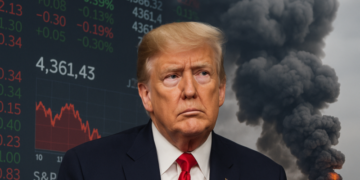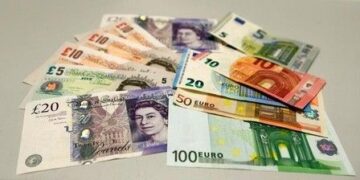(Repeats ANALYSIS originally published on March 28, no changes)
* S&P 500 set for biggest first-quarter decline since 2020
* Investors expect heavy volatility after April 2 tariff
reveal
* Retaliatory tariffs could make Wall Street’s ride even
rockier
NEW YORK, March 28 (Reuters) – U.S. President Donald
Trump’s scheduled April 2 tariff policy announcement could clear
a fog of uncertainty that has clouded financial markets this
year, yet few investors expect to get the definitive guidance
they seek.
Investors entered 2025 bullish about pro-growth government
policies under Trump, but instead the stock market has swooned
since his inauguration. Headlines on tariffs whipsawed Wall
Street, knocking the S&P 500 as much as 10% earlier this month.
The benchmark index is on pace to finish the first
quarter down about 5%, its biggest decline for the first three
months since 2020.
“I’m an eternal bull, but I would tell you that I think that
between now and next week, and certainly the beginning of
earnings season, I think there’s more potential downside than
upside right now,” Mark Malek, Chief Investment Officer at
Siebert Financial said.
The benchmark index tumbled about 2% on Friday after data
showed U.S. consumer spending rebounded in February amid rising
prices for goods and services. The market slide highlights
investors’ sensitivity to any sign Trump’s protectionist trade
agenda could reignite inflation.
The April 2 tariff announcement should reveal which
countries and sectors the Trump administration will target as it
tries to reduce a $1.2 trillion global goods trade deficit.
Heavy volatility is expected, with stock prices swinging
wildly on factors such as how steep the tariffs will be, their
duration, which countries and sectors they will target and any
retaliatory measures from trading partners.
“Uncertainty has continued to plague the market with
volatility,” said Michael Arone, chief investment strategist for
State Street Global Advisors.
“There is potential for more volatility on April 2 and post
that deadline,” Arone said.
On Thursday, governments from Ottawa to Paris threatened
retaliation after Trump unveiled a 25% tariff on imported
vehicles, hammering auto stocks and testing already strained
ties with allies.
The April 2 announcement is likely “not a one-and-done
event,” said Angelo Kourkafas, senior investment strategist at
Edward Jones.
“It is an important milestone, but at the end of the day, it
doesn’t completely really clear out all the uncertainties that
potentially still remain,” Kourkafas said.
ALL SPINACH AND NO CANDY
The market reaction on April 2 “will depend heavily” on
timing for future tariffs, especially sectoral tariffs, and how
fast other countries could retaliate to reciprocal tariffs, said
Matthew Aks, senior strategist at Evercore ISI.
“If other countries retaliate, that will create the risk of
an escalatory cycle that could dampen any feeling of relief,” he
said.
On Wednesday, strategists at Barclays slashed their 2025
target price for the S&P 500 to 5,900 from 6,600, based on an
expectation that earnings take a hit as tariffs feed a material
slowdown in U.S. activity that stops short of recession.
The bank trimmed its 2025 S&P 500 EPS estimate to $262 from
$271, implying moderately below-trend growth, due to a hit from
tariffs, with discretionary stocks among the most vulnerable.
On Friday, UBS Global Wealth Management cut the S&P 500’s
2025 target to 6,400 from 6,600 and trimmed 2025 S&P 500 EPS
forecast by $5 to $265.
The risks are not all to the downside. The recent stock
selloff could tempt buyers should the administration’s tariff
moves fall short of the market’s worst fears.
“I don’t think there’s anything that would happen that would
surprise the market to the downside,” said Harris Financial
Group Managing Partner Jamie Cox, who would view any fresh bout
of weakness as a buying opportunity.
Some said the tariff deadline could allow Trump to pivot to
more market-friendly policies, including tax cuts.
“I think they’re going to start shifting gears and move from
tariffs,” Robert Pavlik, senior portfolio manager at Dakota
Wealth, said.
“That won’t go away completely, but there will be more
emphasis on the tax talk. That’s what I’m hoping for.”
That could drive a rebound in investors’ appetite for risky
assets.
“It’s been all spinach and no candy so far, but I think the
candy is likely coming later in the year,” State Street’s Arone
said.
During Trump’s first term, stocks took a tumble as a
U.S.-China trade war heated up with the S&P 500 shedding about
18% between January and December 2018. The index went on to
recover all the lost ground within about three months as trade
war concerns eased.
Still, investors worry that an extended back-and-forth on
tariffs boosts chances for lasting damage to the U.S. economy.
U.S. consumer confidence plunged to the lowest level in more
than four years in March, as investors worried more about a
recession and higher inflation due to tariffs.
“I have not seen movement in confidence like this that has
not had some negative impact somewhere,” Siebert’s Malek said.
The stock market’s recent bout of nerves is largely driven by
concern that tariffs would significantly weaken the economy,
said John Canavan, lead analyst at Oxford Economics. Some recent
weakness could spill into the second quarter, Canavan said.
Uncertainty on tariffs has so far discouraged investors from
buying shares at a discount following Wall Street’s quarterly
decline.
“Getting greater clarity will allow markets to move higher,”
State Street’s Arone said.
“I am still skeptical that will get that clarity … we are
hoping for it, but we will see,” he said.
(Reporting by Saqib Iqbal Ahmed and Lewis Krauskopf; Additional
reporting by Carolina Mandl; editing by Megan Davies and David
Gregorio)
















